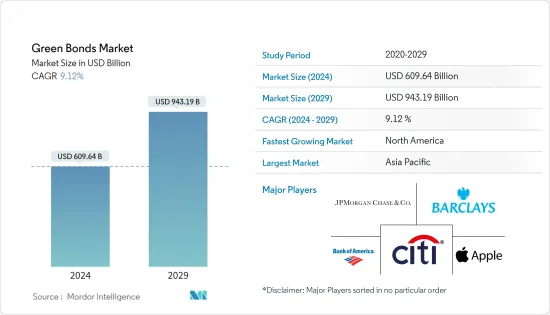PUBLISHER: Mordor Intelligence | PRODUCT CODE: 1521572

PUBLISHER: Mordor Intelligence | PRODUCT CODE: 1521572
Green Bonds - Market Share Analysis, Industry Trends & Statistics, Growth Forecasts (2024 - 2029)
The Green Bonds Market size is estimated at USD 609.64 billion in 2024, and is expected to reach USD 943.19 billion by 2029, growing at a CAGR of 9.12% during the forecast period (2024-2029).

Over the past ten years, the market for green bonds has grown significantly as sustainability and climate change have gained prominence on a worldwide scale. Green bonds are debt securities that are created especially to fund environmentally beneficial projects. They allow issuers to raise capital for projects that promote renewable energy, energy efficiency, sustainable infrastructure, clean transportation, and other environmentally friendly initiatives. Since its launch, the green bond market has experienced impressive development.
The market has continued to expand, with issuances from various entities, including corporations, governments, municipalities, and development banks. The green bond market has attracted many investors, including institutional investors, asset managers, pension funds, and retail investors. Green bonds offer a means of engaging in sustainable investing, as investors are increasingly incorporating incorporating governance, social, and environmental (ESG) factors into their investment plan. The market has also witnessed the emergence of dedicated green bond funds and indices, further driving investor interest.
Green Bonds Market Trends
Increasing Loans is Fuelling the Market
Green bonds are debt products created especially to fund environmentally beneficial projects. Projects that advance sustainability, such as energy efficiency, clean transportation, renewable energy, and climate change adaptation, are funded with the proceeds from green bonds. It would be more correct to state that investor demand and regulatory support are the main forces behind the market's expansion rather than the fact that loans play an indirect role by supplying financing to companies that issue green bonds. Although loans specifically for green projects might help finance eco-friendly projects, the market for green bonds is not driven by loans per se.
Increasing Green Bonds Market in Asia-Pacific
The Asia-Pacific area has seen a rise in the issuance of green bonds in recent years, which is indicative of the growing interest in sustainable finance and tackling environmental issues. China, Japan, and South Korea are just a few of the Asia-Pacific nations committed to having a strong commitment to ecological preservation and sustainable growth. These nations' governments have enacted laws and policies to support green finance, which has made it easier for the issue of green bonds to increase. The Asia-Pacific area has a lot of infrastructure demands, such as programs for climate adaptation, sustainable transportation, and renewable energy. As a means of meeting these demands and guaranteeing that projects follow environmental guidelines, green bonds have surfaced. Green bond issuing has aided in financing initiatives that support the sustainable development objectives of the area.
Green Bonds Industry Overview
The green bonds market is moderately consolidated, with regional and global players. Some of the major players in the market globally include Apple Inc., Bank of America, JP Morgan Chase, Barclays, and Citigroup, among others. In the study period, market players were also involved in mergers and acquisitions, and partnerships focused on expanding their presence in the market. The market opportunities will help the market growth during the forecast period, which is expected to drive the market competition further.
Additional Benefits:
- The market estimate (ME) sheet in Excel format
- 3 months of analyst support
TABLE OF CONTENTS
1 INTRODUCTION
- 1.1 Study Assumptions and Market Definition
- 1.2 Scope of the Study
2 RESEARCH METHODOLOGY
3 EXECUTIVE SUMMARY
4 MARKET DYNAMICS
- 4.1 Market Overview
- 4.2 Market Drivers
- 4.2.1 Growing Number of Investors
- 4.3 Market Restraints
- 4.3.1 Small Size of the Green Bond Market Compared to Traditional Bond Market
- 4.4 Market Opportunities
- 4.4.1 Increasing Interest in Green Bonds Among Government Agencies
- 4.5 Porters 5 Force Analysis
- 4.5.1 Threat of New Entrants
- 4.5.2 Bargaining Power of Buyers/Consumers
- 4.5.3 Bargaining Power of Suppliers
- 4.5.4 Threat of Substitute Products
- 4.5.5 Intensity of Competitive Rivalry
- 4.6 Insights on Technological Innovations in the Market
- 4.7 Impact of Covid-19 on the Market
5 MARKET SEGMENTATION
- 5.1 By Issuer
- 5.1.1 Public Sector Issuers
- 5.1.2 Private Sector Issuers
- 5.2 By Sectors
- 5.2.1 Government Backed Entities
- 5.2.2 Financial Corporations
- 5.2.3 Non-Financial Corporations
- 5.2.4 Development Banks
- 5.2.5 Local Government
- 5.2.6 Others
- 5.3 Geography
- 5.3.1 North America
- 5.3.1.1 United States
- 5.3.1.2 Canada
- 5.3.1.3 Rest of North America
- 5.3.2 Europe
- 5.3.2.1 Germany
- 5.3.2.2 United Kingdom
- 5.3.2.3 Russia
- 5.3.2.4 Rest of Europe
- 5.3.3 Asia Pacific
- 5.3.3.1 India
- 5.3.3.2 China
- 5.3.3.3 Japan
- 5.3.3.4 Rest of Asia Pacific
- 5.3.4 South America
- 5.3.4.1 Brazil
- 5.3.4.2 Argentina
- 5.3.4.3 Rest of South America
- 5.3.5 Middle East and Africa
- 5.3.5.1 UAE
- 5.3.5.2 Saudi Arabia
- 5.3.5.3 South Africa
- 5.3.5.4 Rest of Middle East
- 5.3.1 North America
6 COMPETITIVE LANDSCAPE
- 6.1 Market Concentration
- 6.2 Company Profiles
- 6.2.1 Apple Inc
- 6.2.2 Bank of America
- 6.2.3 JP Morgan Chase
- 6.2.4 Barclays
- 6.2.5 Citigroup
- 6.2.6 Credit Agricole
- 6.2.7 BNP Paribas
- 6.2.8 HSBC Holdings
- 6.2.9 Deutsche Bank
- 6.2.10 Iberdrola SA*
7 MARKET FUTURE TRENDS
8 DISCLAIMER AND ABOUT US




